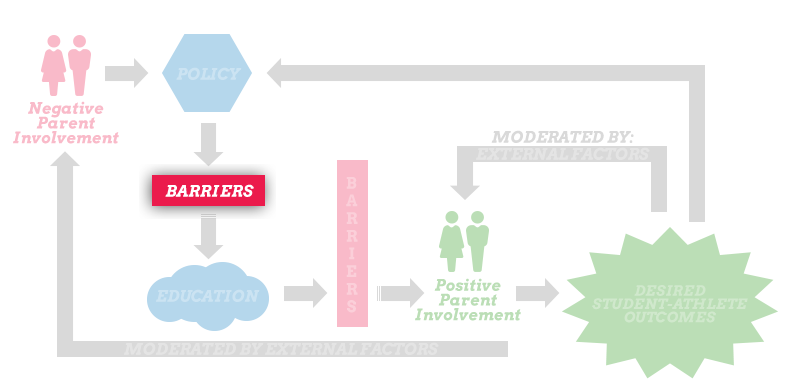
Barriers to Educational Programming
Despite the positive endorsement of the need for the aforementioned policy considerations, coaches and administrators offered a number of potential barriers related to the implementation of evidence-based parent education in the context of intercollegiate athletics. Primarily, participants expressed four main barriers that would impede the implementation of educational programming across NCAA Divisions:
University buy-in.
In order for parent educational programming to be successful, coaches and administrators believed that it would need to have overwhelming support from the University. Specifically, this meant buy-in from university administrators, athletic administrators, coaching staffs, and support staff. As a male head coach (women’s swimming) stated:
If the parent education program educated the parents in a way that (the university) or the coaches did not agree with … then it’s a negative.
Feasibility.
In addition to university buy-in, key NCAA stakeholders noted that any program implemented at a campus level must actually be feasible. Indeed, coaches, administrators, and parents discussed the potential difficulty of gathering parents in a common location to take part in any form of in-person educational programming. A female head coach (women’s soccer) noted this as a potential barrier:
I don’t think it is realistic because you are never going to get all the parents together, with out-of-state kids. We have about 2/3 that are from in-state, but even with that we have one Hawaiian, and her parents can’t afford to come over more than once a year, for a game.
In light of this, most stakeholders felt that the most efficient form of educational programming would occur online through videos, presentations, and example vignettes.
Timing.
Another barrier discussed by key stakeholders across NCAA Divisions centered on the timing of educational programming for parents. Primarily, individuals debated the age and/or class level of student-athletes whose parents should be targeted. They also noted that younger student-athletes have parents with less accumulated experience, but that sometimes parents of older student-athletes are the ones who feel more “invested” in the program and/or entitled. A female assistant coach (women’s basketball) spoke to this issue as a potential barrier, noting that parents of student-athletes are going to be more willing to participate in parent programming when their student-athlete is new to the program rather than after they have settled into their roles in the second or third year:
I think freshman parents would be the best targets because they are almost like freshman themselves. They always have big eyes, and a lot of questions and they want to do what they are supposed to do. I think they would love it. I think after the first year, parents aren’t going to be too into it.
The majority of stakeholders also described parents as becoming less involved as their student-athletes develop and become more independent. Not surprisingly, they overwhelmingly agreed that the most impact would likely then be made on parents of first-year student-athletes (i.e., freshmen and transfers).
Funding.
The final barrier to implementing parent educational programming at a campus level was funding. Across the board, key stakeholders noted that that a lack of funding already limits the scope of most intercollegiate athletic programs. Therefore, coaches and administrators questioned where funding could or would come from to implement parent education on a recurring basis. A male assistant coach (men’s basketball) said:
Obviously funding, money is always an issue, especially when you don’t have any.
Despite the majority of coaches and administrators being excited about the potential positive impact of parent educational programming, they were all concerned about where funding would come from to afford the development and implementation of this needed program.
